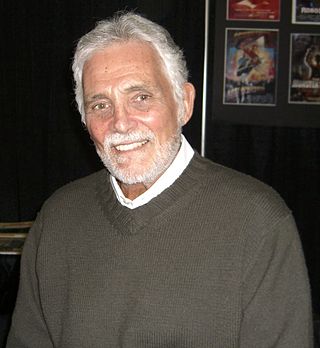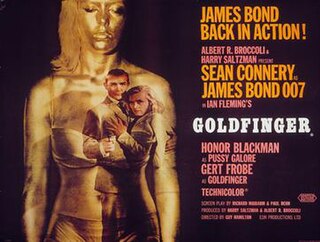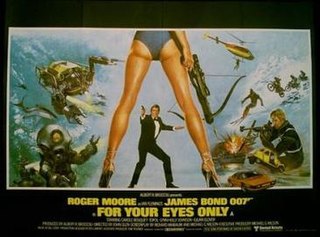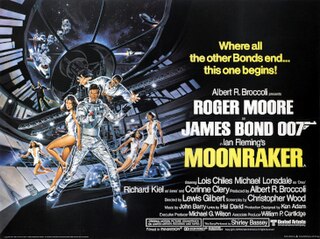
Sir Roger George Moore was an English actor. He was the third actor to portray fictional secret agent James Bond in the Eon Productions/MGM Studios film series, playing the character in seven feature films between 1973 and 1985. Moore's seven appearances as Bond, from Live and Let Die to A View to a Kill, are the most of any actor in the Eon-produced entries.
M is a codename held by a number of fictional characters in Ian Fleming's James Bond book and film series; the characters are the current or past Chief of the Secret Intelligence Service, the agency known as MI6. Fleming based the character on a number of people he knew who commanded sections of British intelligence. M has appeared in the novels by Fleming and seven continuation authors, as well as appearing in twenty-four films. In the Eon Productions series of films, M has been portrayed by four actors: Bernard Lee, Robert Brown, Judi Dench and Ralph Fiennes, the incumbent; in the two independent productions, M was played by John Huston, David Niven and Edward Fox.

GoldenEye is a 1995 spy film, the seventeenth in the James Bond Series produced by Eon Productions, and the first to star Pierce Brosnan as the fictional MI6 agent James Bond. Directed by Martin Campbell, it was the first in the series not to utilize any story elements from the works of novelist Ian Fleming. It was also the first James Bond film not produced by Albert R. Broccoli, following his stepping down from Eon Productions and replacement by his daughter, Barbara Broccoli. The story was conceived and written by Michael France, with later collaboration by other writers. In the film, Bond fights to prevent a rogue ex-MI6 agent from using a satellite weapon against London to cause a global financial meltdown.

Felix Leiter is a fictional character created by Ian Fleming in the James Bond books, films and other media. The character is an operative for the CIA and Bond's friend. After losing a leg and his hand to a shark attack, Leiter joined the Pinkerton Detective Agency. The name "Felix" comes from the middle name of Fleming's friend Ivar Bryce, while the name "Leiter" was the surname of Fleming's friend Marion Oates Leiter Charles, the then wife of Thomas Leiter.

Licence to Kill is a 1989 action-thriller film, the sixteenth in the James Bond series produced by Eon Productions, and the second and final film to star Timothy Dalton as the MI6 agent James Bond. It sees Bond suspended from MI6 as he pursues the drug lord Franz Sanchez, who has ordered an attack against Bond's CIA friend Felix Leiter and the murder of Felix's wife after their wedding.

Octopussy is a 1983 spy film and the thirteenth in the James Bond series produced by Eon Productions. It is the sixth to star Roger Moore as the MI6 agent James Bond. It was directed by John Glen and the screenplay was written by George MacDonald Fraser, Richard Maibaum and Michael G. Wilson.

A View to a Kill is a 1985 spy film and the fourteenth in the James Bond series produced by Eon Productions, and is the seventh and final appearance of Roger Moore as the fictional MI6 agent James Bond. Although the title is adapted from Ian Fleming's 1960 short story "From a View to a Kill", the film has an entirely original screenplay. In A View to a Kill, Bond is pitted against Max Zorin, who plans to destroy California's Silicon Valley.

Albert David Hedison Jr. was an American film, television, and stage actor. He was billed as Al Hedison in his early film work until 1959 when he was cast in the role of Victor Sebastian in the short-lived espionage television series Five Fingers. NBC insisted that he change his name and he proposed his middle name; he was billed as David Hedison from then on. He was known for his roles as the titular character in The Fly (1958), Captain Lee Crane in the television science fiction drama Voyage to the Bottom of the Sea (1964–1968), and CIA agent Felix Leiter in two James Bond films, Live and Let Die (1973) and Licence to Kill (1989).

The Man with the Golden Gun is a 1974 spy film and the ninth in the James Bond series produced by Eon Productions, and the second to star Roger Moore as the fictional MI6 agent James Bond. A loose adaptation of Ian Fleming's posthumously published 1965 novel of the same name, the film has Bond sent after the Solex Agitator, a breakthrough technological solution to contemporary energy shortages, while facing the assassin Francisco Scaramanga, the "Man with the Golden Gun". The action culminates in a duel between them that settles the fate of the Solex.

Goldfinger is a 1964 spy film and the third instalment in the James Bond series produced by Eon Productions, starring Sean Connery as the fictional MI6 agent James Bond. It is based on the 1959 novel of the same name by Ian Fleming. The film also stars Honor Blackman as Pussy Galore and Gert Fröbe as the title character Auric Goldfinger, along with Shirley Eaton as the ill-fated Jill Masterson. Goldfinger was produced by Albert R. Broccoli and Harry Saltzman and was the first of four Bond films directed by Guy Hamilton.

For Your Eyes Only is a 1981 spy film directed by John Glen and produced by Albert R. Broccoli. The film stars Roger Moore as the fictional MI6 agent James Bond, and co-stars Carole Bouquet, Chaim Topol, Lynn-Holly Johnson and Julian Glover.

Dr. No is a 1962 spy film directed by Terence Young. It is the first film in the James Bond series. Starring Sean Connery, Ursula Andress, Joseph Wiseman and Jack Lord, it was adapted by Richard Maibaum, Johanna Harwood, and Berkely Mather from the 1958 novel of the same name by Ian Fleming. The film was produced by Harry Saltzman and Albert R. Broccoli, a partnership that continued until 1975. It was followed by From Russia with Love in 1963. In the film, James Bond is sent to Jamaica to investigate the disappearance of a fellow British agent. The trail leads him to the underground base of Dr. Julius No, who is plotting to disrupt an early American space launch from Cape Canaveral with a radio beam weapon.

Live and Let Die is a 1973 spy film. It is the eighth film in the James Bond series produced by Eon Productions, and the first to star Roger Moore as the fictional MI6 agent James Bond. It was directed by Guy Hamilton and produced by Albert R. Broccoli and Harry Saltzman, while Tom Mankiewicz wrote the script. Although the producers had approached Sean Connery to return after Diamonds Are Forever (1971), he declined and a search for a new actor led to Moore being signed.

Moonraker is a 1979 spy-fi film, the eleventh in the James Bond series produced by Eon Productions, and the fourth to star Roger Moore as the fictional MI6 agent James Bond. The third and final film in the series to be directed by Lewis Gilbert, it co-stars Lois Chiles, Michael Lonsdale, Corinne Cléry, and Richard Kiel. Bond investigates the theft of a Space Shuttle, leading him to Hugo Drax, the owner of the shuttle's manufacturing firm. Along with space scientist Dr. Holly Goodhead, Bond follows the trail from California to Venice, Rio de Janeiro, the Amazon rainforest, and finally into outer space to prevent a plot to wipe out the world population and to recreate humanity with a master race.
MI6-HQ.com is a media-website dedicated to the people, places and world of James Bond, providing regular updates on the subject.
The James Bond film series is a British series of spy films based on the fictional character of MI6 agent James Bond, "007", who originally appeared in a series of books by Ian Fleming. It is one of the longest continually running film series in history, having been in ongoing production from 1962 to the present. In that time, Eon Productions has produced 25 films as of 2021, most of them at Pinewood Studios. With a combined gross of over $7 billion, the films produced by Eon constitute the fifth-highest-grossing film series. Six actors have portrayed 007 in the Eon series, the latest being Daniel Craig.
The James Bond series of films contain a number of repeating, distinctive motifs which date from the series' inception with Dr. No in 1962. The series consists of twenty five films produced by Eon Productions featuring the James Bond character, a fictional British Secret Service agent. The most recent instalment is No Time to Die, released in UK cinemas on 30 September 2021. There have also been two independently made features, the satirical Casino Royale, released in 1967, and the 1983 film Never Say Never Again.
Ian Fleming, the writer who created the fictional character James Bond, lived to see the success of his novels depicted on screen before he died. All fourteen books in the series created by Fleming went on to be huge successes on screen. Goldfinger, one of the most epic stories in the James Bond saga, became a fan favourite with Shirley Bassey singing the iconic song, "Goldfinger", that was played for the fiftieth anniversary of the Bond series at the Oscars in 2012. Bond was played by Sean Connery and George Lazenby in the films shot throughout the 1960s. The Bond movies were filmed all across the world and by different directors each time, with some of the old directors collaborating with the new ones. The success of each Bond film lead to bigger budget prices for the following films adapted to the big screen. Each film recovered its budget and won critically acclaimed awards the years that they came out. Of all the Bond films in cinema today, Thunderball is the most successful with the whole Bond series being the third highest grossing of all time in Hollywood cinema.
Films made in the 1970s featuring the character of James Bond included Diamonds Are Forever, Live and Let Die, The Man with the Golden Gun, The Spy Who Loved Me, and Moonraker.
Films made in the 1990s featuring the character of James Bond are GoldenEye, Tomorrow Never Dies, and The World Is Not Enough. The films are notable for several "firsts": The first Bond film starring Pierce Brosnan as James Bond (GoldenEye); the first appearance of the Walther P99 as Bond's pistol ; and the first Bond film in which the titular spy drives a BMW, all as part of a three-film product placement deal with the manufacturer.












